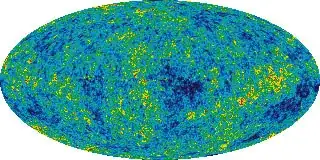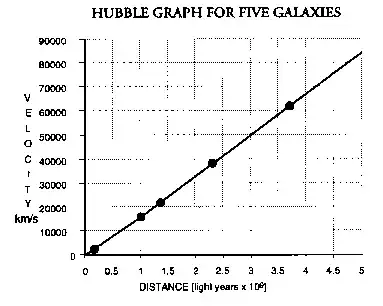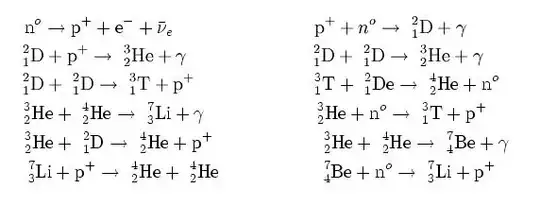Is there any observable evidence of The Big Bang?
-
10I don't think this is a skeptic question, but more of a physics one... – fred Apr 19 '11 at 14:13
-
it demands for observable evidence like many other questions on skeptics so i though it would be appropriate at skeptics. – Lincity Apr 19 '11 at 14:17
-
1You mean observable by a normal person? Hardly. But I would think there are a lot of scientific observations and data which support it. The notable outward-drifting of the galaxies for example. – Martin Scharrer Apr 19 '11 at 14:20
-
2IMHO, there is no skeptical question here. You are explicitly asking for facts, not questioning their validity or comparing to other theories. – fred Apr 19 '11 at 14:21
-
2I'll leave up to the community to close (however I feel this is no different from "Is the Earth 6,000 years old?") – Sklivvz Apr 19 '11 at 14:28
-
@Martin it did not say a normal person in the question the results should be observable and that's it. – Lincity Apr 19 '11 at 14:31
-
I'm looking forward to the tag `big-bang-theory-tv-show`! – Andrew Grimm Apr 21 '11 at 10:00
-
I think it should be moved to astronomy.se site. – user Jun 18 '11 at 15:39
-
It airs every thursday on TBS – Publius Mar 15 '13 at 09:01
-
1It is certainly a skeptic question, but it is *better suited* for a different stack exchange where it is more particularly on topic. – Kaz Mar 22 '13 at 21:20
-
@Kaz it's not for skeptics in its current form. He does not provide any supposedly credible claims that the BB didn't happen for example. If there were an astronomy.se it'd belong there. – jwenting Mar 25 '13 at 07:26
-
1I think this question is a good candidate for applying a [Historical Lock](http://meta.stackexchange.com/questions/126587/what-is-a-historical-lock-and-what-is-it-used-for). – Oct 23 '13 at 23:26
-
1This question appears to be off-topic because it is about basic Physics, where it has already been answered. – Rory Alsop Oct 24 '13 at 12:29
3 Answers
There's plenty of evidence:
We see the "aftermath" of the explosion (the cosmic microwave background)

We see the other galaxies receding from ours with speeds proportional to the distance (which is consistent with an expansion of the universe)

General relativity does not allow for a static universe, and general relativity is very well supported by experiment

The general big-bang cosmology correctly predicts nucleosynthesis (i.e. the relative abundances of atoms in the universe).

On the other hand there are still particulars we don't understand:
-
3I am wary of using the word "explosion" for describing the Big Bang. It gives a false picture of what happened/is happening, as if it was an explosion of matter into space. The phrase "expansion of space" is more suitable. – MSpeed Apr 19 '11 at 14:35
-
There were both, actually and the CMB is not the remnant of the expansion of space, no? – Sklivvz Apr 19 '11 at 14:36
-
From my understanding (admittedly limited), matter wasn't formed until later. I just think the word "explosion" makes people think of a small ball of matter exploding like a bomb, which isn't really helpful. – MSpeed Apr 19 '11 at 14:46
-
I get your point, but I'll stick to the [definition](http://oxforddictionaries.com/view/entry/m_en_gb0076490#m_en_gb0076490): "the explosion of dense matter which according to current cosmological theories marked the origin of the universe." – Sklivvz Apr 19 '11 at 15:05
-
1Personally I would use *"very well supported"* rather than *"well proven"* when discussion GR, simply because there are still corners of the theory that are in play. Albeit, any competing theory would also have to have gravitational redshift, lensing, and time dilation.When LIGO gets a hit we get that much more convinced. – dmckee --- ex-moderator kitten Apr 19 '11 at 17:15
-
There's a few good videos explaining the "Big Bang" on the [Cosmology and Astronomy section](http://www.khanacademy.org/#cosmology-and-astronomy) of the Khan Academy. – Ezra Apr 19 '11 at 21:36
-
@dmckee, I've changed it, although it is somewhat a matter of preference and personal interpretation :-) – Sklivvz Apr 20 '11 at 05:51
-
@Sklivvz Argh, it really bothers me that the OED contains a false analogy. – MSpeed Apr 20 '11 at 08:04
-
I'm certainly not qualified as a physicist, but I did want to add to the mix that what we call the big bang singularity isn't the only solution to the relativity equations. Stephen Hawking in particular rejects the necessity of a singularity - see http://en.wikipedia.org/wiki/Hartle%E2%80%93Hawking_state – John Craft Apr 20 '11 at 16:11
-
Whilst this may theoretically answer the question, [it would be preferable](http://meta.stackexchange.com/q/8259) to include the essential parts of the answer here, and provide the link for reference. Explain the content of the links in plain words, don' just link to the answer. ;) – Borror0 Feb 11 '12 at 05:53
-
Since the Big Bang paradigm is well entrenched I thought that skeptics may be interested in an alternative view.
In two previous threads in sci.astrophysics.research called "static universe" and "static universe - reply" I gave references to papers that argue that "Observational evidence favors a static universe". Unfortunately the discussion in these threads got bogged down in s series of claims and counter-claims that only touched on the major result of these papers. In addition many may have found that the length of the 96 page paper daunting. Here I will give a very brief outline of the crucial results. For all references, caveats and full details see arXiv 1009.0953: http://arxiv.org/abs/1009.0953 (it includes a table of contents, hyperlinks and several minor corrections) or see these papers in the Journal of Cosmology that investigate this proposal. The references are:
- http://journalofcosmology.com/crawford1.pdf: 2022, JCos, 13, 3875-3946
- http://journalofcosmology.com/crawford2.pdf: 2022, JCos, 13, 3947-3999
- http://journalofcosmology.com/crawford3.pdf: 2022, JCos, 13, 4000-4057
A major difference between cosmologies in an expanding universe and that in a static universe is time dilation. Whereas a tired light process could explain the energy loss of photons it cannot produce the effect of time dilation on the rate of arrival of photons. In an expanding universe cosmology the equations for the distance modulus and for the angular size include a term, (1+z), to allow for time dilation. Since the similar equations for a static-universe cosmology do not include this term its presence (or absence) makes a suitable test for determining whether the universe is expanding. It is assumed that the static universe obeys the perfect cosmological principle. The same everywhere and at all times.
Tolman surface brightness.
Sandage and Lubin analyzed the surface brightness of early-type galaxies. A re-analysis using current Big Bang (BB) equations and combining the two color bands (and for the Sersic radius 2.0) gives an exponent of 2.16+/-0.13. The expected exponent is 4. The difference is attributed to luminosity evolution. A critical part of this analysis is the calibration of the absolute luminosity (and hence the SB) for the absolute radii of the galaxies. Thus BB is used to compute the radii of the distant galaxies. The surface brightness has a dependence on the radius of SB = 9.29 + 2.83log(absolute radius). Assuming that for a static universe the radii are all larger by a factor (1+z) then the static universe exponent is 2.16 - 2.83/2.5 = 1.03(+/-0.14) which is in excellent agreement with the expected value of 1. Note Lubin and Sandage claim that their results are inconsistent with a static universe. However they used their own tired-light model which is different to the simple model used here.
Angular size.
Recently Lopez-Corredoira (2010) used 393 galaxies with redshift range of 0:2 < z < 3:2 and found that in agreement with much earlier work the data was consistent with a Euclidean geometry and was totally unable to fit the data to an expanding universe.
Type 1a supernovae.
Here the analysis is more complex and is based on the assumption that these supernovae have constant energy and not constant peak luminosity. There is no observational difference between peak luminosity and total energy for nearby supernovae. The total energy is a product of the peak luminosity and the width of the light curve. The critical part of the analysis is that the distant supernovae have been selected to have a very small variation in their peak luminosity computed with BB. In a static universe this means that the selected supernovae are biased to a lower luminosity (by a factor of 1+z). Then if on average their total energy is constant then their widths are biased to larger values. On average a selection bias of (1+z) to lower luminosity corresponds to a selection bias of (1+z) in width. Exactly what is observed. A fit of total energy verses redshift has a function (19.070+-042) + (0.047+-0.089)2.5log(1 + z) which is consistent with zero slope. Thus no evidence of dark energy!
Gamma ray bursts.
A remarkable characteristic of gamma ray bursts is that the raw observations of the various time measures (burst duration, spike rise time and spike rate) do not show any significant variation with redshift (out to z=6). The standard explanation is that there is an inverse relationship between absolute luminosity and the time measures and the lack of variation in the time measures is due to selection effects. In a static universe the lack of variation is expected and the relationship with absolute luminosity is spurious and due to the use of an incorrect distance modulus.
Galaxy luminosity function.
It is shown that E-S_a galaxies have a well defined luminosity distribution with a peak that has essentially the same shape at all redshifts but the position of the peak varies with redshift. When analyzed for a static cosmology the magnitude of this peak has a constant value independent of redshift with a Chi^2 of 6.1 for 3 degrees of freedom.
Quasar luminosity distribution.
At a fixed redshift the SDSS quasars essentially have a power law distribution (exponential in magnitude). Since the distance modulus is additive and for a small range of redshifts is essentially constant it can be derived from the distribution of magnitudes within that redshift range. The sum of the probability of detection for each quasar in the range multiplied by the exponential of the luminosity function is set equal to the expected number of quasars. The only complication is the co-moving volume and density of the quasars. Assuming the reasonable assumption that the the static universe has the same volume as a function of z as BB and that the quasar density is constant the analysis shows a well defined preference for a static universe. A BB model can only fit the data if it has a density evolution.
Quasar variability in time.
Hawkins has analyzed the time variability of 800 quasars over time scales from 50 days to 28 years. He finds that there is no dependence of the time variability on redshift.
The Butcher-Oemler effect.
They observed that the fraction of blue galaxies in galactic clusters appears to increase with redshift. Andreon, Lobo & Iovino (2004) examined three clusters around z=0.7 and did not find clear-cut evidence for the effect. To quote one of their conclusions: "Twenty years after the original intuition by Butcher & Oemler, we are still in the process of ascertaining the reality of the Butcher-Oemler effect".
- 78,578
- 29
- 321
- 428
- 129
- 2
-
1[As discussed on meta](http://meta.skeptics.stackexchange.com/questions/132/list-of-useful-sources-for-skeptics-se), you need to provide better references than arxiv. – Sklivvz Apr 20 '11 at 05:57
-
4What do you mean. My paper(s) have been published in the refereed Journal of Cosmology. Does the place of publication somehow invalidate the arguments. – David F. Crawford Apr 20 '11 at 07:11
-
1The place of publication does not invalidate your points, but it's just that anyone can publish to arxiv. Maybe you could also point to the JoC article, as well as arxiv? – Sklivvz Apr 20 '11 at 08:25
-
4Recently I have published three papers in the Journal of Cosmology that investigates this proposal. The references are: http://journalofcosmology.com/crawford1.pdf: 2022, JCos, 13, 3875-3946 http://journalofcosmology.com/crawford2.pdf: 2022, JCos, 13, 3947-3999 http://journalofcosmology.com/crawford3.pdf: 2022, JCos, 13, 4000-4057 – David F. Crawford Apr 20 '11 at 21:02
-
1
-
4This sort of thing really is beyond the scope of reasonable discussion on skeptics and probably needs to be @physics. I do note that Dr. Crawford--who appears to be very well-learned--is citing his own research and as such is problematic. I do know that he denies the existence of black holes in his book, which certainly places him outside of the mainstream at this moment. The implications of which I am certainly incapable of discussing. – horatio Apr 21 '11 at 17:48
-
1@horation, it's not problematic at all as long as his research is peer-reviewed, it stops being anectodal and it becomes a very reasonable piece of evidence. – Sklivvz Apr 22 '11 at 14:10
-
5There is a non-trivial history of alternative theories that are considered good science even as they are widely thought to be wrong (e.g. MOND approaches to issues that were usually treated with dark matter were considered viable long-shots for a long time). That is, not everyone offering strange and unpopular theories is a crank or crackpot. Such people often have to publish in less popular journals and no one thinks the worse of them for it. That said, The Journal of Cosmology is [very much "less-popular"](http://en.wikipedia.org/wiki/Journal_of_Cosmology#Reliability). – dmckee --- ex-moderator kitten May 30 '12 at 15:17
-
About angulat size: maybe it's your phrasing, but it comes of as if Euclidean geometry and expanding universe are antithetical. [But the curvature of the universe is unrelated to it expanding or not.](http://en.wikipedia.org/wiki/Friedmann%E2%80%93Lema%C3%AEtre%E2%80%93Robertson%E2%80%93Walker_metric) – Raskolnikov Mar 17 '13 at 17:42
All the evidence that is observed in the universe support BOTH the big bang theory and ALSO its dual: 'The matter is shrinking' (We measure with 'atomic' sizes and atomic 'clocks' that we presume invariants, without proof)
|Universe | begining: the Size of Universe ('M' represents Mass, 's' for Space)
|MMMsssMMM| at t0: distributed by 2 atoms and space with sizes multiple of M and of s
|MMsssssMM| at t1: redistributed with more space
|MsssssssM| at t2: much more expanding space and the same 2 'shrinked' atoms.
|Universe | ending: space expanded and matter shrinked, and equal size of the Univ.
All the references presented (in some of other answers) support what I'm saying.
There is no reference in the literature contrary to what I said, IMO.
EDIT add
Answer to your question:
As both theories can not coexist, I conclude that the evidence does not favor the BBT.
EDIT add end
quote WP Comoving_distance
Comoving coordinates are an example of such a natural coordinate choice. They assign constant spatial coordinate values to observers who perceive the universe as isotropic. A comoving observer is the only observer that will perceive the universe, including the cosmic microwave background radiation, to be isotropic. Space in comoving coordinates is usually referred to as being "static", as most bodies on the scale of galaxies or larger are approximately comoving, and comoving bodies have static, unchanging comoving coordinates. So for a given pair of comoving galaxies, while the proper distance between them would have been smaller in the past and will become larger in the future due to the expansion of space, the comoving distance between them remains constant at all times.
ADVICE: The following IS A NON PEER REVIEW PAPER.
all equations and details can be found in this model:
A relativistic time variation of matter/space fits both local and cosmic data
On the other hand these particulars disapeared (and many others like the BB singularity):
- Did the universe have an inflationary period? Why?
- Why did the big bang have such a low entropy?
- Why is the expansion of the universe accelerating?
- 147
- 3
-
Shrinking matter will also have to get closer to other shrinking matter, and then it is not only an alternative explanation to the Big Bang, it is exactly the same theory, just in different time-dependent units of length. – Ron Maimon Mar 27 '12 at 07:07
-
@Ron , please read the paper. By eq 10 you will have to change your oppinion. A model whith only 1 parameter ($H_0$) explains the observations wihout Dark Energy, No BB, No inflation and you say that its the same model ? see [PSE-2nd law breaks with the gravitation in an homogeneous universe](http://physics.stackexchange.com/a/22660/1257) for a different 'start'. – Helder Velez Mar 28 '12 at 03:51